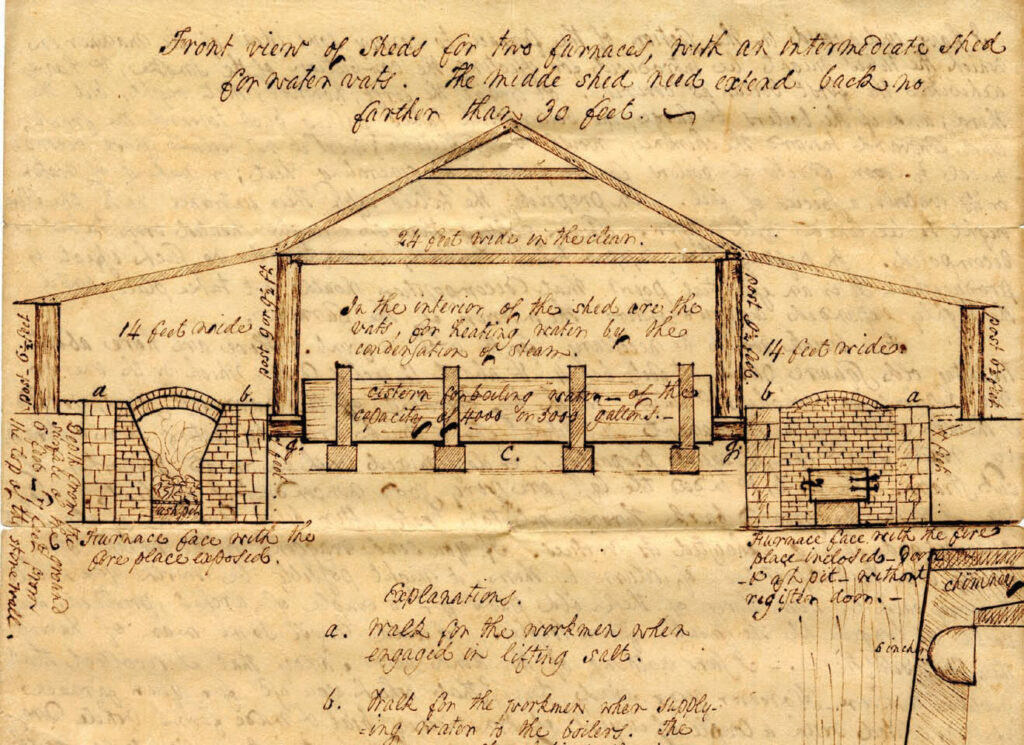By Rebecca Mead
The Saltworks Diagram image found at the Filson Historical Society. For more information, please visit: https://www.filsonhistorical.org/archive/news_v7n4_browsing.html
Before coal became king, another mineral ruled the hills of Eastern Kentucky: salt. In the late 18th and early 19th centuries, salt was not only essential to survival—it was the backbone of Appalachian economy and migration. Across the rugged hills of Pike, Clay, and Perry Counties, salt licks and brine springs drew long hunters, settlers, and entrepreneurs deep into what was then the Western frontier.
Salt: The Original Appalachian Industry
Before railroads or coal mines, before formal counties or courthouses, salt licks—natural springs where animals and people sought mineral-rich water—were among the first destinations for westward migrants. Following buffalo trails and Native paths, pioneers like Daniel Boone passed through the Cumberland Gap and followed the Great Warrior’s Path into Kentucky in search of land, fresh water, and this precious mineral.
Salt’s value went beyond taste—it preserved meat through long winters, tanned leather, nourished livestock, and even served as a form of currency. Early salt works were vital to settlement, as their presence made a remote area livable.
Pike County: Where the Story Begins
Pike County, nestled deep in the Appalachian folds, holds some of Kentucky’s earliest and most historically rich salt sites:
- Boone’s Salt Spring, on Lick Fork of Middle Creek, is believed to have been visited by Daniel Boone in 1767. Though no permanent settlement was formed at the time, the spring is emblematic of how early explorers sought out salt-rich sites.
- Lick Branch of Shelby Creek and Fowler’s Lick on Salt Lick Branch of Right Beaver Creek were recorded in surveys as early as the 1780s. These natural mineral springs formed the nucleus of what became industrial-scale salt production.
- Middle Creek Salt Works, established by James Young in 1779, later became a strategic Civil War asset. Located in Floyd County but deeply tied to Pike County migration and commerce, it supplied salt to local communities and military units before being destroyed by Union troops in 1862.
These sites not only fueled local economies but also influenced family migration routes, with settlers clustering near production hubs to ensure access to salt.
Explore More: Dive into these early salt operations and regional history at the Pike County Historical Society.
Clay County: Salt Capital of Kentucky
While Pike County initiated salt exploration, Clay County became Kentucky’s salt capital.
- Founded by Colonel John White in the early 1800s, White’s Salt Works—also known as the Goose Creek Salt Works—was the most productive in the state.
- Located near the confluence of the Goose Creek and Red Bird Rivers, it used kettles and steam power to boil brine extracted from salt-rich earth.
- By the 1820s, Clay County was producing 150,000+ bushels of salt per year, becoming a major supplier for Kentucky and surrounding states.
This industrial success directly led to the founding of Manchester, Clay’s county seat, in 1807. During the War of 1812, White’s Salt Works supplied troops, and in the Civil War, Union troops destroyed it to prevent Confederate use—a pattern repeated across Eastern Kentucky.
Perry County: The Brashear Family Legacy
In Perry County, the Brashear family established a large-scale salt operation in 1834 near modern-day Cornettsville. Known as Brashear’s Salt Works, it became the leading industrial site in the county.
- By the mid-19th century, it was producing massive quantities of salt for local trade.
- In the 1860s, Confederate General Humphrey Marshall seized the works to supply Southern troops. The Union later targeted the site to disrupt those efforts.
Though few physical remnants remain, Brashear’s Salt Works was a key player in Perry County’s early economic development and remains a site of regional significance.
Appalachian Migration and the Salt Trade
Salt played a hidden but powerful role in Appalachian migration patterns. Families settling in salt-producing regions often stayed for generations, giving rise to surnames that still echo in the hills: Brashear, White, Young, Cornett, Combs, Mullins, Ramey, Sizemore, Chavis—and many more.
These early economic hubs gave birth to communities and clans, some of whom would later migrate outward from the Kentucky heartland into Tennessee, Virginia, West Virginia, and Ohio.
Salt and the Civil War: A Commodity of Strategy
Salt wasn’t just commercially valuable—it was militarily strategic. During the Civil War:
- Confederates took control of key works in Perry and Clay Counties.
- Union troops, recognizing salt’s importance, destroyed these facilities to cut off enemy supplies.
- Many salt works never reopened post-war, as refrigeration, changing technology, and industrialization shifted food preservation elsewhere.
What remains today is a ghost trail of Kentucky’s first industry, overshadowed but not erased.
Visiting Eastern Kentucky’s Historic Salt Sites
Interested in walking the paths of salt barons, Civil War soldiers, and early settlers? These sites offer both history and travel inspiration:
- Clay County (Goose Creek Salt Works) – Visit Manchester, the town salt built. Explore courthouse archives, riverside trails, and salt history through the Clay County Genealogy Project.
- Brashear’s Salt Works Marker – Located in Cornettsville, Perry County, this historic marker honors the legacy of Perry County’s largest 19th-century operation.
- Middle Creek Salt Works & Battlefield (Floyd County) – Explore the area near Prestonsburg, rich in both Civil War history and salt heritage.
- Boone’s Salt Spring (Pike County) – Though remote, this legendary site offers a quiet, reflective glimpse into frontier life.
- Pike County Historical Society – Begin your exploration at pikecountykyhistoricalsociety.com, where you’ll find maps, documents, and local guides.
For even more historical exploration, check out:
- ExploreKYHistory: Boone’s Salt Springs
- MapQuest: Salt Works Historical Marker
- Civil War Salt Sites of Eastern KY
Salted Into Our Story
From Pike County’s licks and legends to Clay County’s industrial might, Eastern Kentucky’s salt boom was more than an economic event—it was a cultural genesis. These salt works laid the foundations of Appalachian migration, resilience, and identity. Though many of these sites are now quiet and wooded, their impact lingers in every road, surname, and local tale still told around kitchen tables and courthouse steps.
The Appalachian Magazine is dedicated to remembering, honoring, and sharing the stories that shaped the Mountain South. Subscribe today and follow us on Facebook for more Appalachian history, culture, and living heritage.







